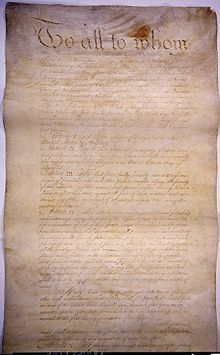Articles of Confederation
| Articles of Confederation | |
|---|---|

Page I of the Articles of Confederation
|
|
| Created | November 15, 1777 |
| Ratified | March 1, 1781 |
| Location | National Archives |
| Author(s) | Continental Congress |
| Signatories | Continental Congress |
| Purpose | First constitution for the United States; replaced by the current United States Constitution on September 13, 1788 |
The Articles of Confederation, formally the Articles of Confederation and Perpetual Union, was an agreement among all thirteen original states in the United States of America that served as its first constitution. Its drafting by a committee appointed by the Second Continental Congress began on July 12, 1776, and an approved version was sent to the states for ratification in late 1777. The formal ratification by all thirteen states was completed in early 1781. Government under the Articles was superseded by a new constitution and federal form of government in 1789.
Even unratified, the Articles provided a system for the Continental Congress to direct the American Revolutionary War, conduct diplomacy with Europe and deal with territorial issues and Native American relations. Nevertheless, the weakness of the government created by the Articles became a matter of concern for key nationalists. On March 4, 1789, the general government under the Articles was replaced with the federal government under the United States Constitution. The new Constitution provided for a much stronger federal government by establishing a chief executive (the President), courts, and taxing powers.
The political push to increase cooperation among the then-loyal colonies began with the Albany Congress in 1754 and Benjamin Franklin's proposed Albany Plan of Union, an inter-colonial collaboration to help solve mutual local problems. The Articles of Confederation would bear some resemblance to it. Over the next two decades, some of the basic concepts it addressed would strengthen and others would weaken, particularly the degree of deserved loyalty to the crown. With civil disobedience resulting in coercive, and what the colonials perceived as intolerable acts of Parliament, and armed conflict resulting in dissidents being proclaimed rebels and outside the King's protection, any loyalty remaining shifted toward independence and how to achieve it. In 1775, with events outpacing communications, the Second Continental Congress began acting as the provisional government to run the American Revolutionary War and gain the colonies their collective independence.
...
Wikipedia
